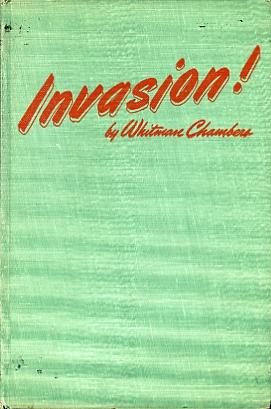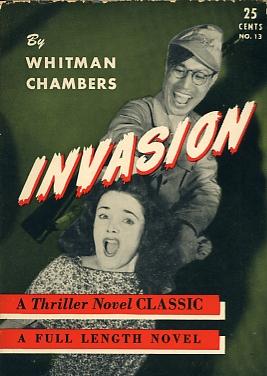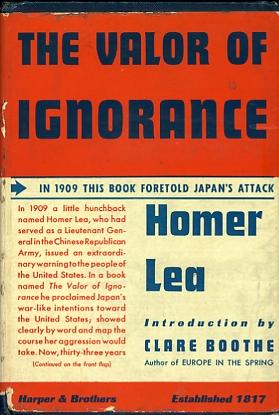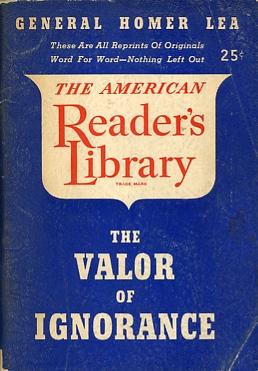Wartime criticism
The invasion and occupation of Los Angeles
By William Wetherall
First posted 5 May 2010
Last updated 7 May 2010
Whitman Chambers, Invasion!, 1943
Homer Lea, The Valor of Ignorance, 1909, 1942
Invasion!During the Pacific War, Whitman Chambers, a writer of mainly western and mystery action stories, took a cue from earlier prophets of peril like Homer Lea, and plotted the path a handful of local denizens might take through the rubble of Los Angeles were the city to be bombed, invaded, and occupied by Japanese forces. The result was a novel called Invasion! -- published in 1943, hence a tale of future war rather than alternative history -- while Lea's The Valor of Ignorance (see below), first published in 1909 and reissued in 1942, was a work of non-fiction. Invasion! appeared after America's victory at Midway, and after Allied Forces had captured most of the Solomon Islands and retaken significant parts of New Guinea. Though partly a "what if" examination of the on-going war, it is really a critique of what the author thought was wrong with America, in addition to being a character study of the kind one expects in such action novels. Hardcover editionWhitman Chambers The volume shown here, a stated first edition, is an ex libris copy with loose boards and no dust jacket. A second printing reportedly had red titles on a lighter cover. Digest editionWhitman Chambers StoryJohn Mercer takes refuge in a sewer rather that be evacuated with his wife after Japanese forces have landed and begun to sweep east. He is found by Happy McGonigle, the leader of a literally underground group of survivors, who encourages Mercer to help him harrass Japanese forces until the cavalry comes. As the story unfolds, more is revealed about the survivors, what they had been doing before the war and how it is changing them. Adding to the tensions are interpersonal, including romantic conficts, ideological divides, and disputes over fight-or-flight strategies. News, but also propaganda, are sometimes heard on a radio. The reader has the advantage of quotes, between chapters, of quotes from actual contemporary political statements and magazine and newspaper reports. The action is frequently interruped by heated debate or discussion as to what caused the war, why it continues, and whether America petition for peace and surrender the West Coast, or dig in and fight to the finish. Some of these passages read like monologues and otherwise give the impression that the author contrived the story as a vehicle for his views of what is wrong with American society. The Japanese enemy remains mostly in the background, but now and then the group comes close enough to observe and the enemy and engage in a fight -- leaving more of the group dead. One scene involves substantial dialog between a person who is either a Japanese American, an Americanized Japanese, or a Japanese who is posing as such for the purpose of deception. The development and progress of the story toward the end will come as as a bit of surprise. Post-paranoiaAmong the many novels in English that feature a landing of Japanese military forces on the West Coast of the United States, Invasion!" is significant because it was written during the Pacific War. For a while after Pearl Harbor, the threshold of reasonable paranoia significantly fell. By the time this book was published, however, America's victory at the Battle of Midway is old news, and the United States had also taken the Solomons and New Guinea. Only the most paranoid American would have thought Japan capable of doing anything so desperate as striking the Pacific Coast. This, though, is the pretext of the novel, as is clear from what McGonigle tells Mercer (hard cover page 27-28, digest pages 13-14).
What prompted Chambers to stage the invasion in the area of Los Angeles and Santa Monica is not clear. The idea was not new, and very possibly he had read the 1942 reissue of of Homer Lea's The Valor of Ignorance (see below). INVASION! BY WHITMAN CHAMBERS (1943) Shortly after Pearl Harbor, when invasion hysteria was at its height, Lea's book was reissued (with a new introduction by Clare Booth Luce), stimulating a hack writer named Whitman Chambers to fill in the grisly details. In his version, a Japanese airborne landing in Santa Monica is accompanied by incendiary and poison-gas bombardment that reduces much of L.A. to stucco rubble. A small group of civilian and military survivors, hiding in a Westlake storm drain, are transformed into guerrilla warriors by Happy McGonigle, a middle-aged "newsboy" who delights in killing the Japanese (who are portrayed as apes or insects) with his bare hands. McGonigle's band find their ultimate revenge at the battle-scarred corner of Alvarado Street and Glendale Boulevard, where they surprise a platoon of Japanese soldiers eating oranges (a particularly obscene image to Chambers). Happy delegates the slaughter of the prisoners to a Jewish GI named Abe, while the rest of the band debates the tactics of total race war against the invaders.Biographical noteElwyn Whitman Chambers (1896-1968) was a very prolific writer of mysteries. Many were set in the San Francisco Bay Area, especially Oakland, and many featured a newspaper reporter. Whitman Chambers, sometimes as and E. Whitman Chambers, wrote numerous short stories as well as longer fiction. The following Titles include his most representative works.
|
The Valor of IgnoranceImaginative writers are constantly coming up with new means of destroying Los Angeles. One of the earliest was Homer Lea, who in 1909 proposed a perfectly conventional and, to him, plausible way -- a Japanese military invasion (1942 hardcover edition page 274, digest edition page 142, underscoring mine).
In Lea's scenario, Hawaii and the Pacific Northwest, including Washington and Oregon "without even the probability of a battle" (hardcover page 271, digest page 140). Japan would fein an invasion of San Pedro and gain an easy foothold in Santa Monica Bay. Los Angeles would quickly fall, then Japan would push eastward. Early editionsHomer Lea |
1942 hardcover editionHomer Lea The Pacific War hardcover reissue included a separately paginated introduction by Clare Boothe, followed by the contents, maps, and appendices of the 1909 edition. Introduction by Clare Boothe, undated (circa 1941-1942), 31 pages Preface by Homer Lea, March 1909, 1 page Introduction by Lieutenant-General Adna R. Chaffee, Late Chief-of-Staff, United States Army, undated, 7 pages Introduction by Major-General J.P. Story, U.S.A., Retired, undated, 5 pages The edition described here is an ex libris volume with two library stamps, one for TIMMS LIBRARIES Inc. (Syracuse, N.Y.) and SANGER'S LOAN LIBRARY (no address). An unclipped dust jacket is pasted to the boards. The price was $2.50. Blurbs on jacket of 1942 hardcover editionThe blurbs on the jacket of the 1942 edition tell a story in themselves.
|



